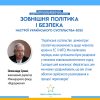Introduction
The Minsk agreements: the art of the negotiable by Kateryna Zarembo and Leonid Litra
The cost of the conflict: paying for guns and butter by Ilona Sologoub, Tymofiy Mylovanov, and Oleksandr Zholud, Vox Ukraine
The swinging pendulum: public opinion on the occupation in the East by Maria Zolkina, Democratic Initiatives Foundation
Unvarnished realities: the conflict on the ground by Vitaliy Syzov and Mykola Zamikula, Donetsk Institute of Information
The sum of its parts by Vlad Galushko, Open Society Initiative for Europe
Conclusions
To read the publication click here.
EXECUTIVE SUMMARY
When spontaneous demonstrations in winter 2013-2014 culminated in the popular uprising known as the Revolution of Dignity, few could have predicted they would trigger a major international crisis and the biggest challenge to Ukraine’s survival since the end of the Cold War. Two and a half years later, the conflict in eastern Ukraine that followed on the heels of the revolution continues to simmer.
Born out of a desperate attempt to halt escalating warfare, the Minsk agreements stanched the casualties and destruction in eastern Ukraine, but failed to stop sporadic fighting and achieve a durable ceasefire. The agreements left each side with too much room to interpret the sequence of steps to end the conflict. Ukraine believes establishing secure conditions in the separatist areas should come before any political steps, while Russia insists on the reverse order. Although they side with Ukraine’s position, the country’s Western partners would like it to proceed with any feasible political steps. Though all the parties appear frustrated with the Minsk framework, none is ready to drop it.
The conflict in the East has exacted a heavy toll on the Ukrainian economy due to the loss of major industrial centers and fertile agricultural land. With an already dire economic crisis deepening, the government has had to reallocate scarce public resources to support the hronically underfunded military and internally displaced persons. The conflict remains a key obstacle to foreign investment, and it has muddied the waters around economic ties with the occupied areas, where opportunities for corruption and smuggling threaten to undo the progress Ukraine has made against the country’s oligarchs.
Given these circumstances, the Ukrainian public is critical of the Minsk agreements, blaming them for the failure to achieve peace and for one-sided political concessions. Most Ukrainians believe the occupied territories should be returned, but differ on how to approach this. The majority prefers a variety of selective concessions to Russia and the self-proclaimed republics to a full-scale military assault, but does not want to see a total surrender to Russian and separatist demands.
Meanwhile, diverging realities are emerging in the occupied and newly liberated territories. In the occupied areas, the education and healthcare systems are aphazardly adopting Russian standards. Citizens there are subject to fierce separatist and Russian propaganda and have limited access to Ukrainian media. Travel restrictions often cement their negative perception of Ukraine as an unwelcoming homeland. In Ukraine’s newly liberated districts, pre-war shortcomings in the social sector are exacerbated by a post-war reality in which a simmering conflict can instantly boil up. The government is struggling to remedy the damage of the occupation without a public consensus on how to interact with these areas.
Moving forward will require examining a number of options and settling on a mix that would ensure the ultimate goal of re-integrating these areas into Ukraine. In foreign policy, the dilemma is whether to stick with the Minsk agreements despite their deficiencies, or to abandon them in hope of a better deal. At present, the advantages of working within the Minsk framework outweigh the negatives, as Ukraine is able to keep its Western partners engaged and achieve incremental progress. In domestic policy, the choices are far more varied, from pursuing complete or limited isolation of the occupied areas,to engaging in partial normalization or their limited re-integration. Each scenario carries advantages and drawbacks.
Putting all the different options on the table for public debate would not only help consolidate public opinion around possible concessions and “red lines,” but also prepare Ukraine for the even more difficult task ahead: bringing the country together to build a truly democratic and European state, which was the original promise of Euromaidan.
This report was produced under the Ukrainian Think Tank Development Initiative (TTDI), which is implemented by the International Renaissance Foundation (IRF) in partnership with the Open Society Initiative for Europe (OSIFE) and the Ukrainian Think Tanks Liaison Office in Brussels. TTDI is funded by the Embassy of Sweden in Ukraine. The views and interpretations expressed in this report are the authors’ and do not necessarily reflect those of the Government of Sweden, IRF and OSIFE.







